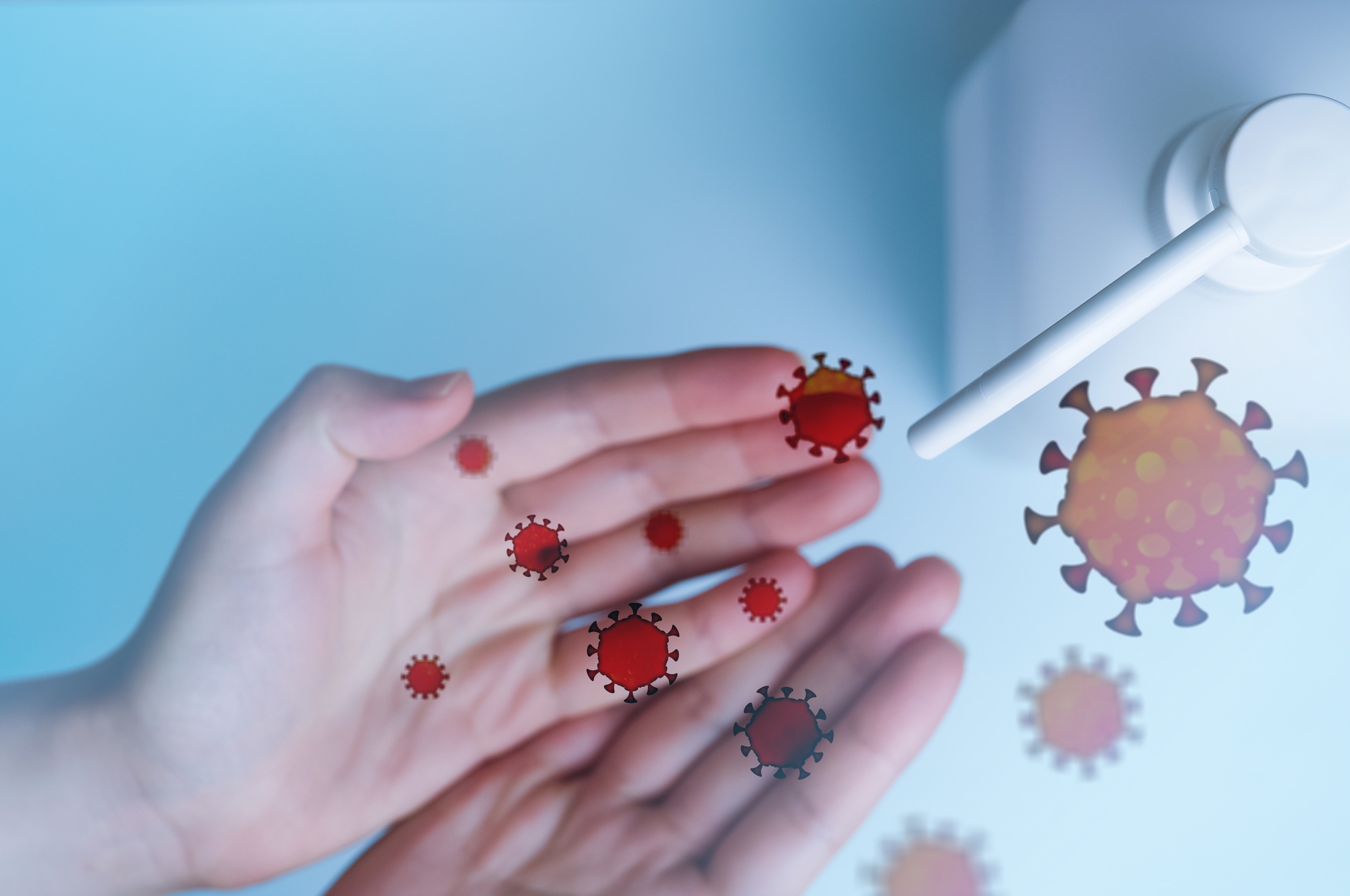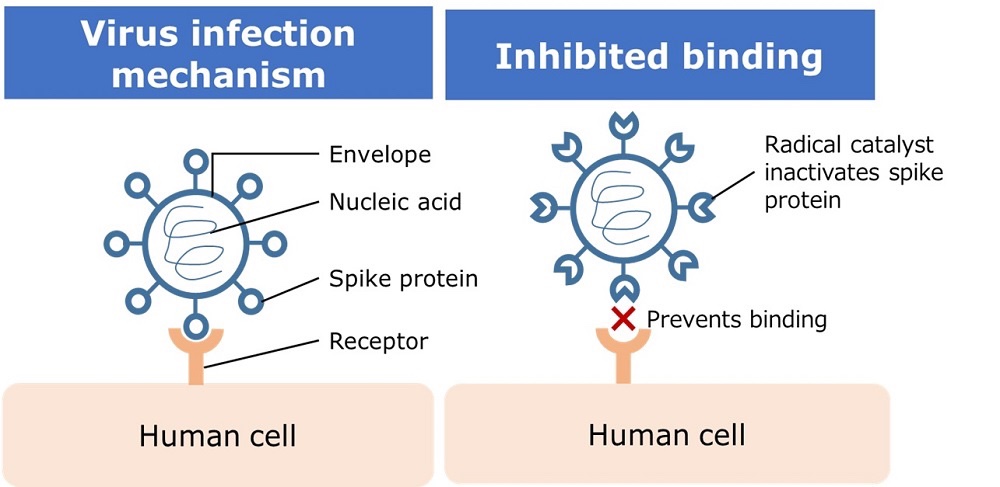

Air Oxidation Catalyst: Inactivates Viruses!
– Decreased infectivity of Corona Omicron strain –
-“Air Oxidation Catalyst” Developed by Nissan-
Nissan Motor
Tohoku University
Jointly developed “air oxidation catalyst technology that inactivates viruses”.
In addition to the effect of preventing the infection of the new corona,
Anti-infection effects against other viruses and pathogens can also be expected.
Automotive antibacterial treatment:
For in-vehicle use, it is expected to be used for air conditioning filters and antibacterial treatment of interiors.
Compared with “conventional technology using metal and alcohol”,
It is highly competitive in terms of “infection prevention effect and cost”.
Additives in car paint:
As an additive for automotive paints, Nissan
It uses an organic nitroxyl radical oxidation catalyst.
We focused on the characteristics of oxidizing organic compounds using oxygen in the air as an oxidizing agent.
Virus inactivation technology:
Developed virus inactivation technology.
organic nitroxyl radical oxidation catalyst,
“Oxidize the protein on the surface of the virus” and prevent it from infecting human cells,
This technology
“No light irradiation required for normal oxidation is required.”
It is said that it is effective even at room temperature and in a dark place.
Validated with Omicron strain:
A decrease in infectivity was confirmed in the Omicron strain of the new corona.
Nissan Research Institute
Chief Examiner Hitoshi Ito
“I think it is also effective for corona mutant strains.”
“Use it by applying it to the car’s air conditioner filter”
“Application to masks and medical textiles” etc.
It is also expected to be used in applications other than cars.
new switch
Catalyseur d’oxydation de l’air : inactive les virus !
– Diminution de l’infectiosité de la souche Corona Omicron –
-“Air Oxidation Catalyst” Développé par Nissan-
Moteur Nissan
Université du Tohoku
“Technologie de catalyseur d’oxydation de l’air développée conjointement qui inactive les virus”.
En plus de l’effet de prévention de l’infection de la nouvelle couronne,
Des effets anti-infectieux contre d’autres virus et agents pathogènes peuvent également être attendus.
Traitement antibactérien automobile :
Pour une utilisation dans les véhicules, il devrait être utilisé pour les filtres de climatisation et le traitement antibactérien des intérieurs.
Par rapport à la “technologie classique utilisant du métal et de l’alcool”,
Il est très compétitif en termes « d’effet et de coût de prévention des infections ».
Additifs dans la peinture automobile :
En tant qu’additif pour les peintures automobiles, Nissan
Il utilise un catalyseur d’oxydation radicalaire organique nitroxyle.
Nous nous sommes concentrés sur les caractéristiques des composés organiques oxydants utilisant l’oxygène de l’air comme agent oxydant.
Technologie d’inactivation des virus :
Développement de la technologie d’inactivation des virus.
catalyseur d’oxydation radicalaire nitroxyle organique,
« Oxyder la protéine à la surface du virus » et l’empêcher d’infecter les cellules humaines,
Cette technologie
“Aucune irradiation lumineuse requise pour une oxydation normale n’est requise.”
On dit qu’il est efficace même à température ambiante et dans un endroit sombre.
Validé avec la souche Omicron :
Une diminution de l’infectivité a été confirmée dans la souche Omicron de la nouvelle couronne.
Institut de recherche Nissan
Chef examinateur Hitoshi Ito
“Je pense qu’il est également efficace pour les souches mutantes corona.”
“Utilisez-le en l’appliquant sur le filtre du climatiseur de la voiture”
“Application aux masques et textiles médicaux” etc.
Il devrait également être utilisé dans des applications autres que les voitures.
nouvel interrupteur
Luftoxidationskatalysator: Inaktiviert Viren!
– Verringerte Infektiosität des Corona-Omicron-Stammes –
-“Air Oxidation Catalyst” entwickelt von Nissan-
Nissan-Motor
Tohoku-Universität
Gemeinsam entwickelte “Luftoxidationskatalysator-Technologie, die Viren inaktiviert”.
Neben der Wirkung, die Ansteckung mit dem neuen Corona zu verhindern,
Auch antiinfektiöse Wirkungen gegen andere Viren und Krankheitserreger sind zu erwarten.
Antibakterielle Behandlung für Autos:
Für die Verwendung in Fahrzeugen wird erwartet, dass es für Klimaanlagenfilter und die antibakterielle Behandlung von Innenräumen verwendet wird.
Verglichen mit “herkömmlicher Technologie mit Metall und Alkohol”,
Es ist in Bezug auf “Infektionspräventionseffekt und Kosten” äußerst wettbewerbsfähig.
Zusatzstoffe im Autolack:
Als Zusatz für Autolacke, Nissan
Es verwendet einen organischen Nitroxyl-Radikal-Oxidationskatalysator.
Wir konzentrierten uns auf die Eigenschaften der Oxidation organischer Verbindungen unter Verwendung von Luftsauerstoff als Oxidationsmittel.
Virusinaktivierungstechnologie:
Entwickelte Vireninaktivierungstechnologie.
organischer Nitroxylradikaloxidationskatalysator,
“Oxidieren Sie das Protein auf der Oberfläche des Virus” und verhindern Sie, dass es menschliche Zellen infiziert,
Diese Technologie
“Für die normale Oxidation ist keine Lichteinstrahlung erforderlich.”
Es wird gesagt, dass es sogar bei Raumtemperatur und an einem dunklen Ort wirksam ist.
Validiert mit Omicron-Stamm:
Beim Omicron-Stamm der neuen Korona wurde eine Abnahme der Infektiosität bestätigt.
Nissan-Forschungsinstitut
Chefprüfer Hitoshi Ito
„Ich denke, es ist auch bei Corona-Mutantenstämmen wirksam.“
“Verwenden Sie es, indem Sie es auf den Klimaanlagenfilter des Autos auftragen”
„Anwendung auf Masken und medizinischen Textilien“ etc.
Es wird erwartet, dass es auch in anderen Anwendungen als Autos verwendet wird.
neuer Schalter
Nissan develops new technology using catalyst active species to inactivate viruses
YOKOHAMA, Japan
Nissan Motor Co., Ltd. today announced it has jointly developed a technology with Tohoku University’s Faculty of Pharmaceutical Sciences
that
The technology has potential applications for inactivating viruses
◦ by oxidizing, denaturing and degrading proteins and other substances on the virus surface.
With oxygen in the air acting as an oxidant,
the catalyst species produces this effect
even under dark conditions at room temperature without requiring light irradiation, as is usually the case with oxidation.
In addition to inactivating viruses
— including the novel coronavirus — this technology can also inactivate pathogens such as fungi and bacteria.
It has the potential for wide-ranging applications in the future,
including use as antibacterial and antiviral base materials in filters for air conditioning equipment and air purifiers, as well as in masks and medical textile products.
This technology utilizes
organic nitroxyl radical oxidation catalysts (radical catalysts).
They oxidize organic compounds in the presence of appropriate co-catalysts using molecular oxygen in ambient air acting as a terminal oxidant.
Studies of this technology’s effects
have found that the oxoammonium salts produced from radical catalysts through aerobic oxidation oxidize and inactivate viruses’ surface proteins,
thereby reducing their ability to bind to target cells.
Furthermore, processing the receptor-binding domain of the spike protein of SARS-CoV2 (omicron strain) significantly reduces the binding of the spike protein to the receptor (see figure below).
Using feline coronavirus — an alternative SARS-CoV2 virus —its infectious activity on feline renal cells was assessed and a notable inhibition of infection-related morphological changes in the cells was observed.
Nissan’s new technology inactivates viruses using catalyst active species | Zigwheels